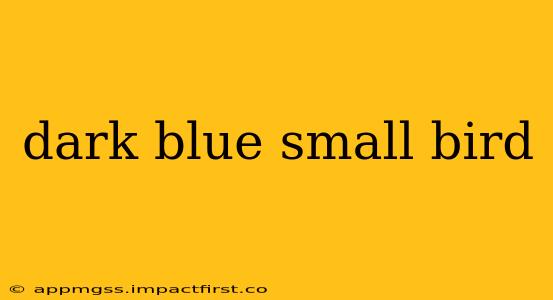The world of small, dark blue birds is surprisingly diverse! Pinpointing a specific species requires more information, but this guide will help you narrow down the possibilities and learn how to identify these captivating creatures. We'll explore various possibilities, covering key identifying features and habitats.
What Kind of Dark Blue Small Bird is It?
This question is crucial! The shade of blue, the bird's size relative to other birds nearby (e.g., a robin), and its location all play a vital role in identification. Is the blue a deep, rich indigo, or a lighter, more vibrant azure? Are there any other noticeable colors present – perhaps a flash of orange, yellow, or brown? These details significantly narrow down the possibilities.
What are Some Common Small Dark Blue Birds?
Several bird species boast a dark blue plumage. Let's examine a few common examples:
-
Bluebirds (various species): Eastern Bluebirds, Western Bluebirds, and Mountain Bluebirds are all known for their beautiful blue coloring, though the shades vary slightly between species. These birds are often found in open fields, meadows, and orchards. They are relatively large for a "small" bird, however, so size comparison is important.
-
Blue Grosbeak: This bird displays a deep, rich blue, particularly in the males. They are slightly larger than many other small blue birds and can be identified by their thick, conical beak.
-
Indigo Bunting: Males are a striking, deep indigo blue. Females are a much more subdued brown. Their size is relatively small, and they are frequently found in shrubby areas and fields.
-
Blue-gray Gnatcatcher: This tiny bird is more of a slate-blue color. They are incredibly small and often found in woodlands and forests, flitting about in the branches. Their size is a key identifier, as they are remarkably diminutive.
Remember, regional variations in bird plumage exist, making precise identification challenging.
Where Did You See This Dark Blue Small Bird?
Geographic location significantly impacts identification. A dark blue bird spotted in the Amazon rainforest will differ dramatically from one seen in a North American backyard. Providing your location helps narrow down the possibilities considerably.
What Size is the Dark Blue Bird Compared to Other Birds?
As mentioned earlier, comparing the size of the bird to familiar species, like robins or sparrows, is crucial. Is it significantly smaller, about the same size, or even larger than these common birds?
What is the Shape and Size of its Beak?
The beak shape offers a valuable clue. A long, thin beak might suggest a bird that feeds on insects, while a conical beak indicates a fondness for seeds. Note the size and shape of the beak in comparison to the bird's overall body size.
What Other Identifying Features Did You Notice?
Take note of any additional features, such as:
- Flight pattern: Do they fly in a straight line or a more erratic pattern?
- Behavior: Are they foraging on the ground, flitting among branches, or singing a particular song?
- Markings: Are there any other colors or patterns besides the blue?
- Habitat: What type of environment did you observe the bird in (forest, field, backyard, etc.)?
By meticulously considering these factors, you'll significantly improve your chances of successfully identifying your dark blue small bird. Remember to use a reputable field guide specific to your region to aid in identification. Happy birding!
